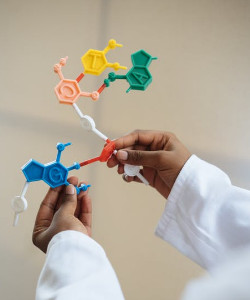Are You Eating Weed-Killer?
Summer is here, which means gardening season is in full swing! It’s time to weed, plant, and dig in the dirt. However, if you’ve been relying on herbicides to keep weeds out of your lawn and garden, it’s to time to reconsider your weed management methods.
Glyphosate, an ingredient in most weed-killers, and is a nonselective herbicide, is genetically designed to kill any plant it comes in contact with. In Stephanie Seneff’s new book Toxic Legacy, she discusses how glyphosate has been found in almost every aspect of our lives, affecting not only human health but also that of the plants and animals around us.
The following excerpt is from Toxic Legacy by Stephanie Seneff. It has been adapted for the web.
Glyphosate and the Microbiome
Glyphosate is considered so safe that no US governmental agency tests for it in food. Many homeowners use it without a second thought to control weeds in their yards. It’s in the rain, the water supply, and the cotton in clothing, dish cloths, tampons, and baby diapers. It aerosolizes, becoming dispersed into the air, which means we breathe it into our lungs. And it’s present in much of what we eat. Even if you eat an organic diet, as I mentioned earlier, it’s likely you’re still being exposed to glyphosate.
The companies that manufacture and sell glyphosate are so powerful that they have convinced government authorities and many research scientists that glyphosate is so safe that they don’t even bother to investigate whether it could be partly to blame when bees and butterflies start dying in alarming numbers. At the same time, we all know that pollution is harming the plants and animals we humans rely on.
 When scientists look at time trends in the United States for multiple diseases that are becoming more prevalent in the past few decades, and compare them to the time trends for the use of glyphosate over the same time period, they find stunning correlations between the rise in glyphosate use and the rise in Alzheimer’s disease, autism, diabetes, inflammatory bowel disease, kidney disease, liver disease, obesity, pancreatic cancer, and thyroid cancer1.
When scientists look at time trends in the United States for multiple diseases that are becoming more prevalent in the past few decades, and compare them to the time trends for the use of glyphosate over the same time period, they find stunning correlations between the rise in glyphosate use and the rise in Alzheimer’s disease, autism, diabetes, inflammatory bowel disease, kidney disease, liver disease, obesity, pancreatic cancer, and thyroid cancer1.
Some dismiss the results of this research with the claim that “correlation does not equal causation.” Fair enough. But consider this: A p-value is a mathematical measure of the probability that a correlation between two curves could have occurred by chance. A p-value of 0.05 is considered significant. As Nancy Swanson and her team of scientists explain, “When correlation coefficients of over 0.95 (with p-value significance levels less than 0.00001) are calculated for a list of diseases that can be directly linked to glyphosate, via its known biological effects, it would be imprudent not to consider causation as a plausible explanation” [my emphasis]2. If exposure to glyphosate is indeed causing the decline in human health in industrialized countries, as I believe it is, we need to ask ourselves how.
Disrupting a Microbial Pathway
Glyphosate’s effect on plants is to disrupt the shikimate pathway, a metabolic pathway that plants use to produce the aromatic amino acids tryptophan, tyrosine, and phenylalanine, which are the precursors to proteins, vitamins, and other kinds of bioactive substances such as pigments, hormones, and neurotransmitters. When glyphosate disrupts the shikimate pathway, it kills the plants. This makes glyphosate an extremely effective herbicide. How other organisms are affected by disruption of the shikimate pathway is a subject of contentious debate.
Monsanto researchers and other industry-funded scientists posit that, because the shikimate pathway does not exist in human cells, glyphosate doesn’t pose a risk for us. As you now know, however, many of the microbes in our bodies do possess the shikimate pathway. Not all bacteria are equally sensitive to glyphosate. A study by researchers in Finland used a bioinformatics approach to predict which microbial species in the gut would be sensitive to glyphosate toxicity. They found that 54 percent of the species found in the gut carry a glyphosate-susceptible version of EPSP synthase3. So while humans can derive these three aromatic amino acids from diet, the bigger issue is this:
Glyphosate kills anything that possesses the shikimate pathway, and that includes much of our microbiome—microbes we rely on for providing us with nutrients, aiding digestion, maintaining a healthy gut barrier, and promoting the development of a healthy immune system.
For example, a genomic assessment of the human microbiota demonstrates that microorganisms collaborate to produce the B vitamins: thiamine (B1), riboflavin (B2), niacin (B3), pantothenate (B5), pyridoxine (B6), biotin (B7), folate (B9), and cobalamin (B12). It further reveals that these B vitamins made inside the body significantly augment B vitamins supplied from food. Our human cells are unable to produce these vitamins. But, collectively, our microbial hitchhikers contain a large number of enzymes that specialize in various steps in the synthesis of these essential nutrients, and many of these microbes are dependent on a working shikimate pathway4.
In plants, fungi, and bacteria, glyphosate’s attack on the shikimate pathway is mainly localized to an enzyme called EPSP synthase. A synthase is an enzyme that links together two molecules to make a third molecule, its product. In the case of EPSP synthase, the two molecules are phosphoenolpyruvate (PEP) and shikimate 3 phosphate (S3P). EPSP synthase pries a phosphate loose from PEP, and this creates energy that allows it to “sew” the remaining piece together with S3P to create 5-enolpyruvylshikimate-3-phosphate (EPSP). The phosphate is important, because it’s the breaking of the high-energy phosphate bond that energizes the reaction. And, as we will see later, glyphosate interferes with the binding of EPSP synthase to PEP at the phosphate site.
EPSP is an intermediary in the shikimate pathway, not the end result. EPSP is further processed by other enzymes to achieve the primary goal of the pathway, which is production of the three aromatic amino acids: tryptophan, tyrosine, and phenylalanine. Human cells do not have any of the enzymes of the shikimate pathway, including EPSP synthase. For this reason, our body depends on our food sources and on our gut microbes to produce these amino acids for us. This is why they’re called essential amino acids. These amino acids are not only essential for building proteins. They are also the building blocks of many other molecules that play a critical role in our biology, including many of the B vitamins; the neurotransmitters serotonin, melatonin, dopamine, and epinephrine; thyroid hormone; and the skin-tanning agent melanin.
Glyphosate has been shown experimentally to block PEP from binding to EPSP synthase, specifically by getting in the way of the phosphate attached to PEP.
Notes
1. Nancy L. Swanson et al., “Genetically Engineered Crops, Glyphosate and the Deterioration of Health in the United States of America,” Journal of Organic Systems 9 (2014): 6–37.
2. Nancy L. Swanson et al., “Genetically Engineered Crops, Glyphosate and the Deterioration of Health in the United States of America,” Journal of Organic Systems 9 (2014): 6–37.
3. Lyydia Leino et al., “Classification of the Glyphosate Target Enzyme (5-Enolpyruvylshikimate-3-Phosphate Synthase) for Assessing Sensitivity of Organisms to the Herbicide,” Journal of Hazardous Materials 2020 (Epub ahead of print); https://doi.org/10.1016/j.jhazmat.2020.124556.
4. Stefanía Magnúsdóttir et al. “Systematic Genome Assessment of B-Vitamin Biosynthesis Suggests Co-operation among Gut Microbes,” Frontiers in Genetics 6 (2015): 148, https://doi.org/10.3389/fgene.2015.00148.
